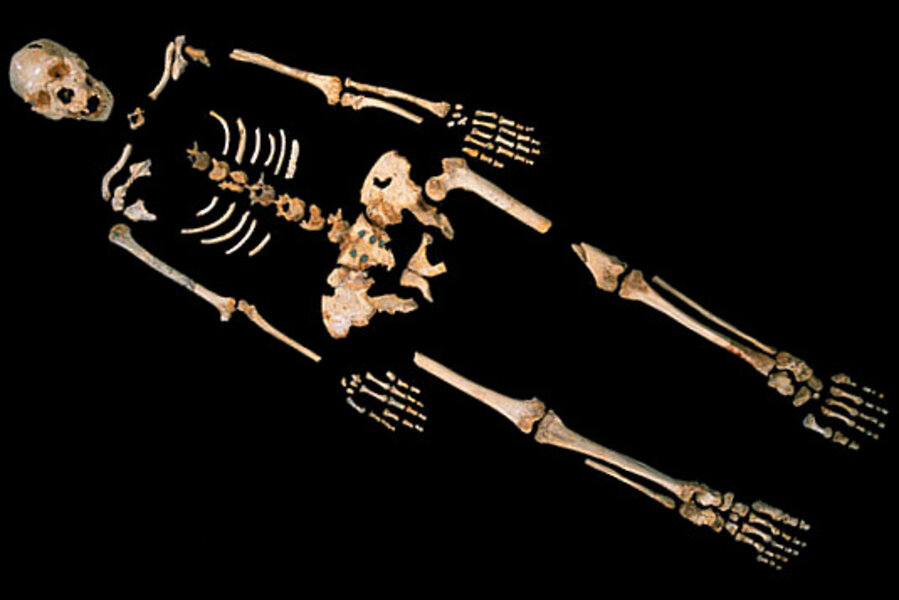Why scientists are baffled by a half-million-year-old human thigh bone
With help from a new technique, a team of geneticists in Germany have mapped the mitochondrial DNA (mtDNA) from a 400,000-year-old thigh bone belonging to one of our ancient cousins. The bone is much too old to be Homo sapiens sapiens, but it also doesn't appear to be Homo sapiens neanderthalensis, our Neanderthal cousins. The previous record for the oldest fragment of DNA was set in 2006, when a team of French and Belgian researchers mapped the mtDNA of a 100,000-year-old Neanderthal tooth.
The German researchers found correlations between the ancient thigh bone and a 40,000-year-old finger bone found in the Denisova Cave in southern Siberia. That bone's DNA was distinctive enough that the team designated a new branch on the human family tree that they called the "Denisovans." But now the genetic connection between the Siberian bone and the newly-sequenced Spanish bone are prompting new questions.
“The fact that the mtDNA of the Sima de los Huesos hominin shares a common ancestor with Denisovan rather than Neanderthal mtDNAs is unexpected since its skeletal remains carry Neanderthal-derived features”, says Matthias Meyer, lead author of a paper in the current issue of Science, in a press release.
The thigh bone was found in Sima de los Huesos, "the pit of bones," a cave in northern Spain. The cave has been largely sealed off for much of the past half-million years, preserving the bones so well that their mtDNA is nearly intact. Until now, the only way to retrieve ancient DNA was from frozen material recovered from the permafrost.
Sima de los Huesos is well named: it has produced the world’s largest collection of hominin fossils more than 100,000 years old. It includes at least 28 different skeletons. Those without Neanderthal features have been classified as Homo heidelbergensis, a vaguely defined species sometimes used as a catchall for ambiguous Homo specimens.
(Note that scientists now use "hominin" instead of "hominid," the previous term for our proto-human ancestors, since genetic studies of our ape cousins have revealed that gorillas, chimps, orangutans, and humans are all technically hominids – all part of the Hominidae family.)
Dr. Meyer and his team at the Planck Institute have developed new techniques for retrieving and sequencing highly degraded ancient DNA, which they first tested on a cave bear bone found at the Sima de los Huesos site. After that success, they gathered a few grains of bone powder from a hominin thigh bone from the cave. They extracted its DNA and sequenced the mitochondrial genome (mtDNA), a small part of the genome that is passed down along the maternal line and occurs in many copies per cell. The researchers then compared this ancient mtDNA with Neanderthals, Denisovans, present-day humans, and apes.
From gaps in the DNA sequences, they calculated that this hominin lived between 125,000 and 640,000 years ago, most likely around 400,000 years ago. After considering the bone's age and Neanderthal-like features, the researchers concluded that the Sima hominins were probably descended from the same group that gave rise to both Neandertals and Denisovans. An alternate theory could be that a small group migrated from Siberia to Spain, bringing the Denisova-like mtDNA into the Sima hominins or their ancestors.
And yet, since the entire Denisovan classification is based on the DNA of one finger bone, which was sequenced last fall, it is possible that these are simply variations within one species, not multiple species. "The discovery of a small finger bone from the Denisovans was pure chance," said Meyer in an interview in August 2012. "It shows absolutely no external difference from the finger of a modern human or Neanderthal."
But the Planck team points to the genetic markers they identified. "The quality of the data is as good as if you were to have your own genome analysed today," said Meyer. "We can even differentiate between the maternal and paternal chromosomes. A comparison of both sets of chromosomes, or genomes, shows us that the parents of our Denisovan were genetically very similar – although they were not related to one another. We can conclude from this that there cannot have been very many of these people."
Modern humans "did not descend from either the Denisovans or the Neanderthals," he added. "The ancestor of the Denisovans and Neanderthals ... developed separately from modern humans and begot both of these humanoids – thus, they are siblings of a sort."
Neanderthals are more closely related to modern humans than to Denisovans, says Meyer, and Denisovans are more closely related to this new Sima genotype than either of them are to Neanderthals or humans. Their branch of the Hominidae family tree split off from ours at least 700,000 years ago, he says.
“We can now study DNA from human ancestors that are hundreds of thousands of years old," says Svante Pääbo, director of the Planck Institute and a coauthor on the paper. "It is tremendously exciting.”
Their next step: retrieve DNA from more individuals from Sima de los Huesos.






